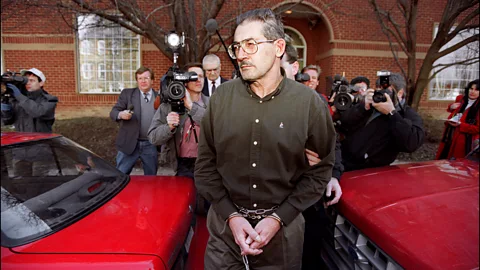How Aldrich Ames became the US's most damaging double agent
 Getty Images
Getty ImagesAldrich Ames spent nearly a decade selling secret information to the Soviet Union, compromising more than 100 clandestine operations, and leading to the deaths of at least 10 Western intelligence assets. On 28 April 1994, the double agent was jailed for life. In February of that year, the BBC spoke to one of the spies who was betrayed by Ames, but who lived to tell the tale.
In 1985, Soviet agents working for the CIA suddenly began to disappear. One by one, these Western intelligence sources were picked up by the Soviet intelligence service, the KGB, interrogated and, very often, executed.
Oleg Gordievsky was one of those double agents. As the KGB's station chief in London, he had been secretly working for the UK's foreign intelligence service, MI6, for years. But one day he found himself in Moscow, drugged, exhausted after five hours of questioning, and facing the very real possibility of death by firing squad. Gordievsky narrowly escaped with his life after MI6 smuggled him out of the Soviet Union in the boot of a car.
Afterwards, Gordievsky tried to work out who had given him up. "For nearly nine years I have been guessing who was the man, who was the source who betrayed me, and I didn't know any answer," he told the BBC's Tom Mangold in an interview with Newsnight on 28 February 1994. Two months later, Gordievsky would get his answer when veteran CIA officer Aldrich Ames stood up in a US courtroom, and confessed to compromising "virtually all Soviet agents of the CIA and other American and foreign services known to me".
On 28 April 1994, Ames itted that he had divulged the identities of more than 30 agents spying for the West, and compromised more than 100 clandestine operations. Known to the KGB by his code name, Kolokol (The Bell), Ames's betrayal had resulted in the execution of at least 10 CIA intelligence assets including General Dmitri Polyakov, a senior official in Soviet army intelligence, who had supplied information to the West for more than 20 years. Ames, the most damaging KGB mole in US history, was convicted and sentenced to life without parole.
Just as British spy Kim Philby's exposure as a Soviet agent in the 1960s had rocked the UK establishment, it was "now Washington's turn to stare in disbelief at the extent of Ames's damage", said Mangold in 1994.
It was Ames's role as head of the CIA's Soviet counterintelligence department that had allowed him to cause such damage. It gave him almost unfettered access to classified information about the US's covert operations against the USSR and, crucially, the identities of its agents in the field. Ames's position had also meant that he could sit in on debriefings from other Western spy agencies. This is how the UK's most valuable spy, Gordievsky, a KGB colonel who was ing vital intelligence to two British services, MI6 and MI5, came into with him. These meetings would create the outlandish situation wherein "the top KGB defector was debriefed by the top KGB mole", said Mangold.
"The Americans were very thorough and really very good at debriefings," said Gordievsky. "I was enthusiastic. I liked the Americans. I wanted to share my knowledge with them, and now I realise [Ames] was sitting there. Which means that everything, all the new answers of my information, he must have ed to the KGB."
Alcohol and divorce
Ames had been exposed to the spy world at an early age. His father was a CIA analyst who helped his son get a job at the Agency after he had dropped out of college. But Ames's later decision to betray the intelligence service would be driven less by ideological misgivings as by his need for money.
Initially, Ames showed promise as a counterintelligence officer. He was first posted with his wife Nancy Segebarth, a fellow CIA agent, to Turkey in the late 1960s, where he was tasked with recruiting foreign agents. But by 1972 his superiors had called Ames back to CIA headquarters, feeling that he wasn't cut out for field work. Back in the US, he studied Russian, and was assigned to planning field operations against Soviet officials.
His father's struggles with alcohol had stalled his CIA career, and, similarly, Ames's own heavy drinking began to derail his progress. In 1972, he was discovered by another agent, intoxicated and in a compromising position with a female CIA employee. The situation was not helped by Ames's lackadaisical attitude to work, which saw him leave a briefcase full of classified information on a subway in 1976.
